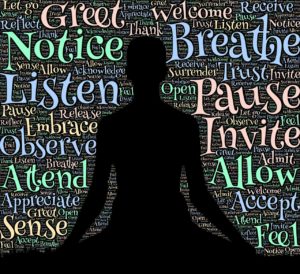Meditation is the practice of thinking deeply or focusing. This can be done in silence or by chanting. It can be done for different reasons, from religious or spiritual purposes to it being a method of relaxation.

Meditation
There are 6 different types of Meditation-
1. Mindfulness Meditation – Mindfulness meditation is from Buddhist teachings. It is one of the most popular of meditation. In this meditation, you pay attention to your thoughts. Mindfulness meditation involves a breathing practice, mental imagery, awareness of body and mind, and muscle and body relaxation.
2. Spiritual Meditation – Spiritual meditation is used in eastern religions like Hinduism and in Christian faith. It’s similar to prayer, where you seek a deeper connection with the Universe. The blessings of spiritual meditation have a ripple effect: as our awareness and spiritual confidence increase, so do our desire and ability to be of benefit to others.
3. Focused Meditation – Focused meditation involves concentration using any of the five senses. One key aspect of mindfulness is the ability to calm and focus the mind. This ability to stabilize and direct the mind is especially important in moments when we may feel stressed, distracted, or overwhelmed. No matter the situation, the ability to calm and focus a busy mind can be beneficial. One specific mindfulness practice that enables us to experience calm and focus in a very direct way is focused on attention training.
4. Movement Meditation – This may include walking, gardening or other gentle forms of motion. It is an active form of meditation where the movement guides you. You begin to pay attention to the body and how it feels as it moves, bends, and twists. Even your breathing, heartbeat, and other inner sensations will be better noticed when you are mindful of the body. Movement meditation focuses on the movements of the body rather than the goal of the movement.
5. Mantra Meditation – Mantra meditation is prominent in many teachings, including Hindu and Buddhist tradition. This type of meditation uses a repetitive word or sound to clear the mind. It makes you more alert and in tune with your environment.
6. Transcendental Meditation – The Transcendental meditation technique is a very simple, natural and effortless way of letting your mind settle down into an extremely calm and wise state of rest. Though TM is not a mantra-based meditation in the sense that its main core and direction is oriented towards transcending, it does involve the use of mantras. By using this mantra, the practitioner experiences the thought of that sound and starts minimizing that thought to experience the finer states of that thought – until the source of thought is fathomed and the conscious mind reaches the transcendental area of begin.
Advantages of Meditation –
1. Lower Blood Pressure – Meditation appears to control blood pressure by relaxing the nerve signals that coordinate heart function, the tension in blood vessels and the “fight-or-flight” response that increases alertness in stressful situations.

Lowers blood pressure
2. It reduces anxiety – In recent years there has been a steady stream of research showing the power of mindfulness meditation to reduce anxiety. Anxiety is a cognitive state connected to an inability to regulate your emotional responses to perceived threats. Mindfulness meditation strengthens a person’s cognitive ability to regulate emotions.

Reduces anxiety
3. It decreases pain -When we are stressed, our bodies trigger the release of stress hormones, causing inflammation, and increasing pain to already irritated joints. Meditation shifts your focus to something quiet and calm, reducing inflammation and pain.

Decreases pain
4. It eases symptoms of depression – Stress and anxiety are major triggers of depression, and meditation can alter your reaction to those feelings. Meditation has been found to change certain brain regions that are specifically linked with depression. Another brain region associated with depression is the amygdala, or “fear center.” This is the part of the brain responsible for the fight-or-flight response, which triggers the adrenal glands to release the stress hormone cortisol in response to fear and perceived danger.

Eases symptoms of depression
5. It improves sleep – If insomnia is at the root of your sleepless nights, it may be worth trying meditation. The deep relaxation technique has been shown to increase sleep time, improve sleep quality, and make it easier to fall (and stay) asleep.

Improves sleep
How to Meditate –
- Sit or lie comfortably.
- Close your eyes.
- Breathe naturally.
- Focus your attention on the breath and on how the body moves with each inhalation and exhalation. Notice the movement of your body as you breathe. Simply focus your attention on your breath without controlling its pace.
The goal of meditation is to go beyond the mind and experience our essential nature—which is described as peace, happiness, and bliss. But as anyone who has tried to meditate knows, the mind itself is the biggest obstacle standing between ourselves and this awareness. At first, you may see progress in terms of physical relaxation and emotional calmness. Later you may notice other, more subtle changes. Some of the most important benefits of meditation make themselves known gradually over time and are not dramatic or easily observed.
